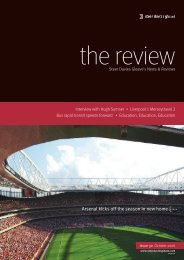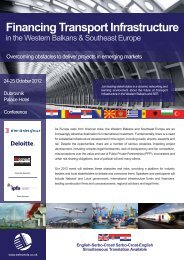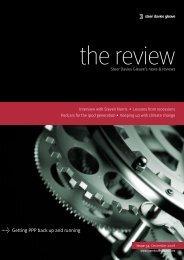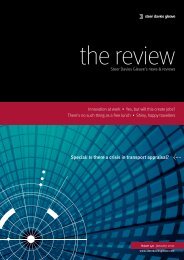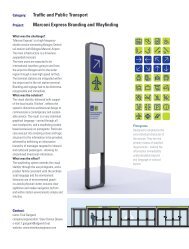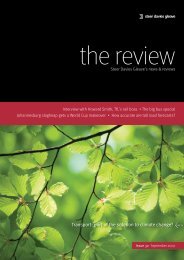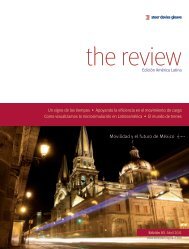California's need for speed - Steer Davies Gleave
California's need for speed - Steer Davies Gleave
California's need for speed - Steer Davies Gleave
You also want an ePaper? Increase the reach of your titles
YUMPU automatically turns print PDFs into web optimized ePapers that Google loves.
Features<br />
tt Cali<strong>for</strong>nia’s <strong>need</strong> <strong>for</strong> <strong>speed</strong><br />
tt How accurate are toll road <strong>for</strong>ecasts<br />
tt Fire and ice: sharing a vision <strong>for</strong> the future<br />
tt Combating climate change<br />
tt Portland’s light rail neighborhoods<br />
Opening comment<br />
Welcome to our first North American edition<br />
of The Review. Over the past 30 years, <strong>Steer</strong><br />
<strong>Davies</strong> <strong>Gleave</strong> has built up a reputation as<br />
the UK’s premier transportation consulting<br />
business and now has a network of 13 offices<br />
around the world. With the opening of our<br />
New York office in January 2008 – our third<br />
office in North America – we felt it was time to<br />
produce a publication that better addressed<br />
the interests and <strong>need</strong>s of our North American<br />
partners and clients.<br />
And the timing couldn’t be better – 2008 is<br />
already proving to be an exciting year <strong>for</strong><br />
transportation in North America. On a global<br />
level, the issues are common: the role of<br />
transportation in combating and contributing<br />
to climate change, growing aspirations from<br />
users with regard to quality transit and the<br />
fundamental challenge of how to fund and<br />
finance important capital programs and<br />
ongoing operations. But nowhere else is the<br />
debate so critical as we watch the race <strong>for</strong> the<br />
White House with eagerness, the debate <strong>for</strong> the<br />
legacy of SAFETEA-LU, the implementation of<br />
the $37 billion Building Canada plan and the<br />
increasing role <strong>for</strong> public private partnerships.<br />
p2<br />
p4<br />
p5<br />
p6<br />
p7<br />
In this issue, we look at the key characteristics<br />
of a successful high <strong>speed</strong> line as Cali<strong>for</strong>nia<br />
considers whether it would be right <strong>for</strong> them,<br />
what transportation policies the UK is looking<br />
into to tackle climate change and a perspective<br />
on transit-oriented development, amongst<br />
other things.<br />
Cali<strong>for</strong>nia’s <strong>need</strong> <strong>for</strong> <strong>speed</strong><br />
By Richard Middleton<br />
The world is no stranger to high <strong>speed</strong> rail<br />
– it’s now been over 50 years since the first<br />
Shinkansen high <strong>speed</strong> rail line opened<br />
between Tokyo and Kyoto and Japan’s<br />
bullet trains have become renowned <strong>for</strong><br />
their <strong>speed</strong> and punctuality. Europe has<br />
also established an impressive network<br />
of high <strong>speed</strong> lines since the Paris to<br />
Lyon TGV began operating in 1981, and<br />
extensive expansion is continuing to<br />
spread rapidly throughout the continent.<br />
In the US, however, railroads never seemed<br />
to quite get back on track since their drastic<br />
decline in the 1950s and 60s and high <strong>speed</strong><br />
rail has certainly been a rare thought in the<br />
American transportation consciousness –<br />
until recently. A few weeks ago, Cali<strong>for</strong>nia’s<br />
governor Arnold Schwarzenegger hosted<br />
an in<strong>for</strong>mation day <strong>for</strong> the development of<br />
a high <strong>speed</strong> rail network. The proposed<br />
Cali<strong>for</strong>nian High Speed Rail (CHSR) network<br />
is a highly ambitious project, which would be<br />
funded through a public private partnership<br />
and cover some 1100 miles from Sacramento<br />
and San Francisco, down through Los<br />
Angeles to San Diego.<br />
With plans to operate at <strong>speed</strong>s of over<br />
200mph, the CHSR would be the first real<br />
high <strong>speed</strong> corridor in the United States.<br />
While the Northeast is also working on a<br />
fast line between Boston, New York and<br />
Washington DC, the North-East corridor is<br />
looking at maximizing the operational<br />
<strong>speed</strong> along an existing rail infrastructure<br />
rather than constructing a whole new<br />
railway alignment.<br />
<strong>Steer</strong> <strong>Davies</strong> <strong>Gleave</strong> has worked with both<br />
sponsors and operators of high <strong>speed</strong><br />
railways over the last 20 years and is<br />
currently providing input on the Portuguese<br />
and Italian systems. From our European<br />
experience, we have put together some of<br />
the key characteristics of a successful high<br />
<strong>speed</strong> line.<br />
Demography – ideally demand should be<br />
concentrated in a few high density cities,<br />
spaced some distance apart, with little in<br />
between to require the trains to slow down<br />
or stop. The Spanish network would be<br />
a good example. The linear nature of the<br />
Italian network, running down the ‘spine’<br />
of the country also benefits the design, by<br />
avoiding too many spur operations.<br />
The proposed Cali<strong>for</strong>nian route also runs<br />
predominantly north – south, connecting a<br />
number of very large centers of population.<br />
Recent work suggests this area is becoming<br />
a mega region (Planning <strong>for</strong> Megaregions –<br />
Journal of Planning Literature 2007); perhaps<br />
comparable with Tokyo-Osaka, another very<br />
successful high <strong>speed</strong> train route.<br />
Frequency – most high <strong>speed</strong> train corridors<br />
operate at high frequencies providing<br />
between 120-160 trains a day. These trains<br />
often provide capacities of 700-1,000 a train<br />
– operating both duplex and double train<br />
<strong>for</strong>mations.<br />
I hope that you find the material useful and<br />
stimulating and welcome your thoughts on<br />
the issues surrounding our industry.<br />
2<br />
Mike Goggin<br />
Head of North<br />
American Operations




